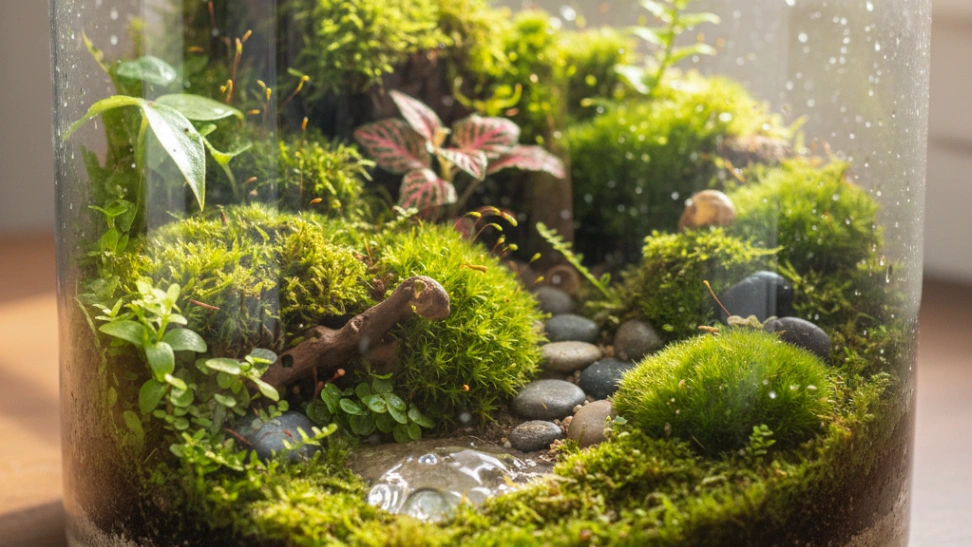The concept of the terrarium dates back to the mid-19th century. In 1827, Nathaniel Bagshaw Ward, a London doctor and amateur botanist, inadvertently discovered the principle while observing an insect pupa in a sealed glass bottle. He noticed that a fern spore and grass seed within the bottle grew and thrived due to the enclosed moisture cycle, without needing external watering. This accidental discovery led him to develop what he initially called a "Wardian case" in 1842, specifically designed for transporting plants, especially delicate ferns, on long sea voyages. Before Wardian cases, transporting exotic plants across oceans was notoriously difficult, with most specimens dying due to harsh conditions. The Wardian case revolutionized horticulture, making it possible to introduce a wide array of new plant species to Europe and beyond, significantly impacting the Victorian gardening craze and the study of botany. These cases were also popular in homes, serving as decorative pieces that allowed people to enjoy exotic plants in urban environments where air pollution made open-air gardening challenging. This historical context is vital, as it highlights the scientific ingenuity and aesthetic appeal inherent in terrarium creation from its very origins. The fundamental principles of the Wardian case, namely the creation of a stable, self-sufficient microclimate, are still at the core of modern terrarium making. The hobby, therefore, carries a rich legacy of botanical exploration and innovation, connecting today's enthusiasts to a past where scientific discovery and natural beauty intertwined to bring the wonders of the plant world closer to human experience.
Modern terrarium making involves selecting an appropriate glass container, which can be open or closed, and then layering specific substrates such as drainage material (pebbles, Leca), a charcoal layer for filtration, and a suitable potting mix. The choice of plants is crucial, as they must be well-suited to the enclosed environment and compatible with each other in terms of light, humidity, and growth rate. Small, slow-growing plants like various mosses, ferns, Fittonia, Peperomia, and succulents are popular choices, depending on whether one is creating a humid closed terrarium or an arid open terrarium. Closed terrariums mimic tropical environments, trapping humidity and recycling water, making them largely self-sufficient. Open terrariums are better for plants that prefer drier conditions, such as succulents and cacti, and require occasional watering. Beyond just plants, terrariums can be accessorized with decorative elements like small stones, driftwood, miniature figurines, or even carefully placed fungi to enhance their aesthetic appeal and create a more complete narrative or landscape within the glass. The creative possibilities are endless, ranging from intricate miniature landscapes to minimalist botanical displays. Each element chosen contributes to the overall health and visual impact of the ecosystem, making every terrarium a unique expression of its creator's vision and understanding of plant needs. This meticulous selection process is part of the hobby's charm, allowing for deep personalization and artistic freedom within the scientific constraints of a living system.
Engaging in terrarium making offers numerous benefits beyond just creating beautiful décor. It's a highly meditative and calming activity, fostering patience and attention to detail. The process of arranging plants and watching a miniature world come to life can be incredibly therapeutic, providing a sense of accomplishment and connection to nature, particularly for those living in urban settings with limited access to outdoor green spaces. Furthermore, it's an excellent way to learn about plant biology, ecosystems, and environmental cycles in a hands-on manner. The hobby also boasts a vibrant online and local community. Enthusiasts often share their creations, tips, and techniques on social media platforms, dedicated forums, and local plant clubs. Workshops are commonly available, allowing beginners to learn from experienced terrarium artists. This community aspect adds another layer of enjoyment, providing opportunities for learning, inspiration, and sharing a passion with like-minded individuals. Whether one is a seasoned botanist or a complete novice, the community welcomes all, offering guidance and encouragement for every step of the terrarium-making journey. This collaborative spirit helps newcomers overcome initial challenges and discover the nuances of plant care within an enclosed environment, fostering a deeper appreciation for botanical artistry and ecological principles. The continuous cycle of learning, creating, and sharing within the community ensures that the hobby remains fresh, engaging, and endlessly rewarding for its participants.



